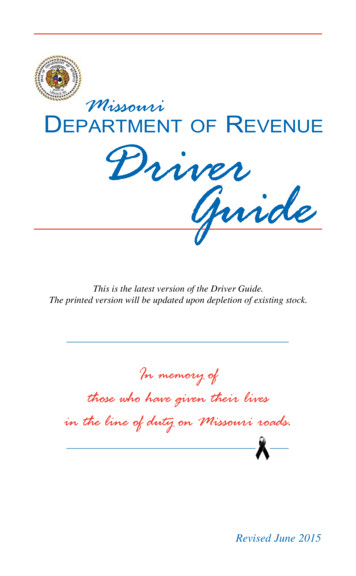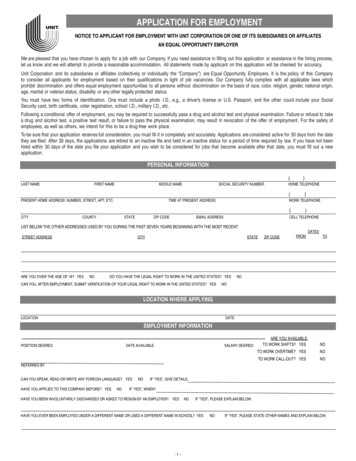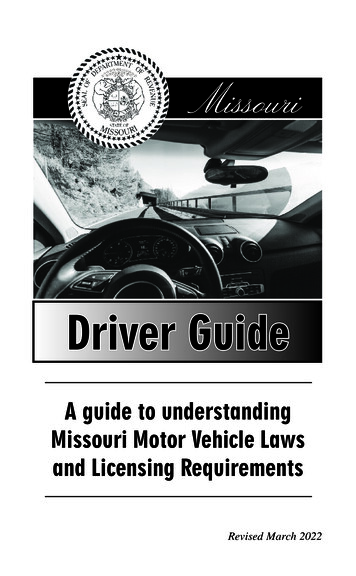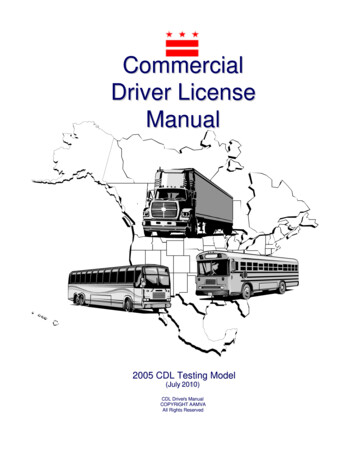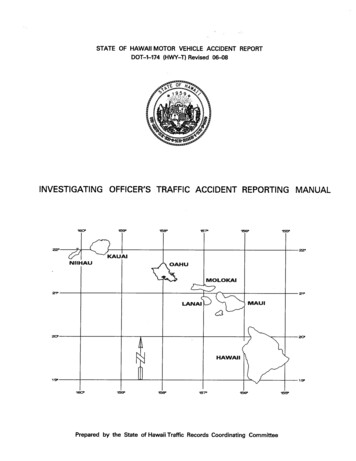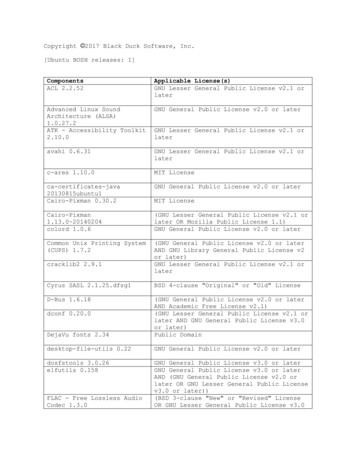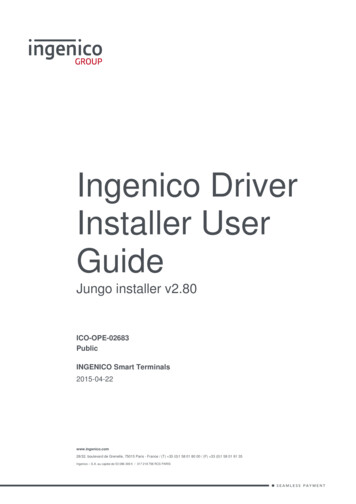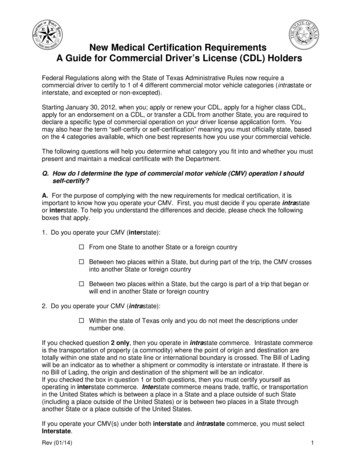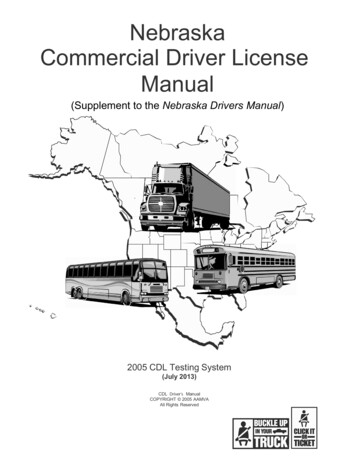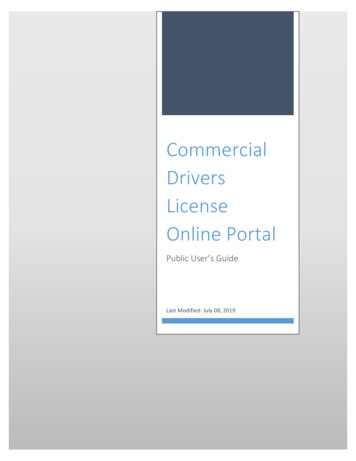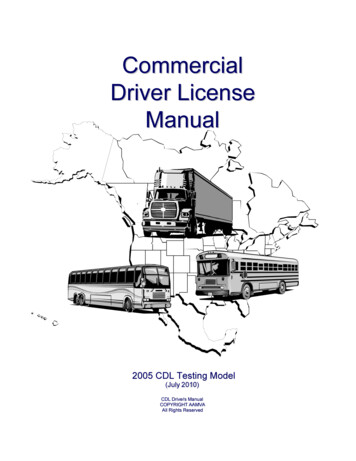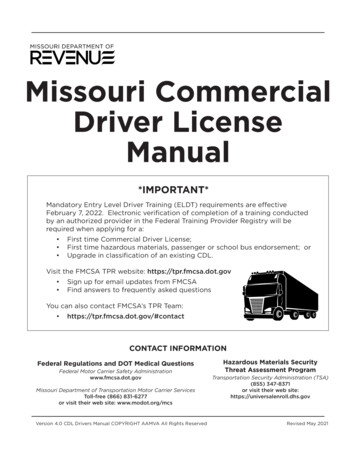
Transcription
Missouri CommercialDriver LicenseManual*IMPORTANT*Mandatory Entry Level Driver Training (ELDT) requirements are effectiveFebruary 7, 2022. Electronic verification of completion of a training conductedby an authorized provider in the Federal Training Provider Registry will berequired when applying for a: First time Commercial Driver License;First time hazardous materials, passenger or school bus endorsement; orUpgrade in classification of an existing CDL.Visit the FMCSA TPR website: https://tpr.fmcsa.dot.gov Sign up for email updates from FMCSAFind answers to frequently asked questionsYou can also contact FMCSA’s TPR Team: https://tpr.fmcsa.dot.gov/#contactCONTACT INFORMATIONFederal Regulations and DOT Medical QuestionsFederal Motor Carrier Safety Administrationwww.fmcsa.dot.govMissouri Department of Transportation Motor Carrier ServicesToll-free (866) 831-6277or visit their web site: www.modot.org/mcsVersion 4.0 CDL Drivers Manual COPYRIGHT AAMVA All Rights ReservedHazardous Materials SecurityThreat Assessment ProgramTransportation Security Administration (TSA)(855) 347-8371or visit their web site:https://universalenroll.dhs.govRevised May 2021
MISSOURI CLASSIFICATION SYSTEM(Note: Certain types of vehicles such as tankers, passenger, school buses, vehicles haulinghazardous materials, and double/triple trailers, will require an endorsement. Please consulttext for particulars.)ClassA*DescriptionAny combination of vehicles with a Gross Combination Weight Rating (GCWR) of 26,001 or morepounds provided the Gross Vehicle Weight Rating (GVWR) of the vehicle(s) being towed is in excessof 10,000 pounds. (Holders of a Class A license may also, with any appropriate endorsements, operateall vehicles within Class B and C.)Examples include but are not limited to:BAny single vehicle with a GVWR of 26,001 or more pounds or any such vehicle towing a vehicle not inexcess of 10,000 pounds GVWR. (Holders of a Class B license may also, with any appropriateendorsements, operate all vehicles within Class C.)Examples include but are not limited to:CAny single vehicle less than 26,001 pounds GVWR or any such vehicle towing a vehicle not in excessof 10,000 pounds GVWR. This group applies only to vehicles which are placarded for hazardousmaterials or are designed to transport 16 or more persons, including the operator. A holder of a ClassA, B or C license may drive all vehicles which may be driven by a holder of a Class E or Class Flicense.Examples include but are not limited to:*The representative vehicle for the skills test must meet the written description for that group. The examplesrepresent, but do not fully cover, the types of vehicles falling within each group.
Table of ContentsPART ONESection 1:1.11.21.3Introduction . . . . . . . . . . . . . . . . . . . . . . . . . . . . . . . . . . . . . . . . . . . . . . . . . . . . . . . . . . . . . . . .Commercial Driver License Tests . . . . . . . . . . . . . . . . . . . . . . . . . . . . . . . . . . . . . . . . . . . . . . .Driver Disqualifications . . . . . . . . . . . . . . . . . . . . . . . . . . . . . . . . . . . . . . . . . . . . . . . . . . . . . . .Other CDL Rules . . . . . . . . . . . . . . . . . . . . . . . . . . . . . . . . . . . . . . . . . . . . . . . . . . . . . . . . . . .1-11-21-31-4Section .152.162.172.182.192.202.212.222.232.24Driving Safely . . . . . . . . . . . . . . . . . . . . . . . . . . . . . . . . . . . . . . . . . . . . . . . . . . . . . . . . . . . . . .Vehicle Inspection . . . . . . . . . . . . . . . . . . . . . . . . . . . . . . . . . . . . . . . . . . . . . . . . . . . . . . . . . .Basic Control of Your Vehicle . . . . . . . . . . . . . . . . . . . . . . . . . . . . . . . . . . . . . . . . . . . . . . . . . .Shifting Gears . . . . . . . . . . . . . . . . . . . . . . . . . . . . . . . . . . . . . . . . . . . . . . . . . . . . . . . . . . . . . .Seeing . . . . . . . . . . . . . . . . . . . . . . . . . . . . . . . . . . . . . . . . . . . . . . . . . . . . . . . . . . . . . . . . . . .Communicating . . . . . . . . . . . . . . . . . . . . . . . . . . . . . . . . . . . . . . . . . . . . . . . . . . . . . . . . . . . . .Controlling Speed . . . . . . . . . . . . . . . . . . . . . . . . . . . . . . . . . . . . . . . . . . . . . . . . . . . . . . . . . . .Managing Space . . . . . . . . . . . . . . . . . . . . . . . . . . . . . . . . . . . . . . . . . . . . . . . . . . . . . . . . . . . .Seeing Hazards . . . . . . . . . . . . . . . . . . . . . . . . . . . . . . . . . . . . . . . . . . . . . . . . . . . . . . . . . . . .Distracted Driving . . . . . . . . . . . . . . . . . . . . . . . . . . . . . . . . . . . . . . . . . . . . . . . . . . . . . . . . . . .Aggressive Drivers/Road Rage . . . . . . . . . . . . . . . . . . . . . . . . . . . . . . . . . . . . . . . . . . . . . . . .Driving at Night . . . . . . . . . . . . . . . . . . . . . . . . . . . . . . . . . . . . . . . . . . . . . . . . . . . . . . . . . . . . .Driving in Fog . . . . . . . . . . . . . . . . . . . . . . . . . . . . . . . . . . . . . . . . . . . . . . . . . . . . . . . . . . . . . .Driving in Winter . . . . . . . . . . . . . . . . . . . . . . . . . . . . . . . . . . . . . . . . . . . . . . . . . . . . . . . . . . . .Driving in Very Hot Weather . . . . . . . . . . . . . . . . . . . . . . . . . . . . . . . . . . . . . . . . . . . . . . . . . . .Railroad - Highway Crossings . . . . . . . . . . . . . . . . . . . . . . . . . . . . . . . . . . . . . . . . . . . . . . . . .Mountain Driving . . . . . . . . . . . . . . . . . . . . . . . . . . . . . . . . . . . . . . . . . . . . . . . . . . . . . . . . . . . .Driving Emergencies . . . . . . . . . . . . . . . . . . . . . . . . . . . . . . . . . . . . . . . . . . . . . . . . . . . . . . . .Antilock Braking Systems (ABS) . . . . . . . . . . . . . . . . . . . . . . . . . . . . . . . . . . . . . . . . . . . . . . .Skid Control and Recovery . . . . . . . . . . . . . . . . . . . . . . . . . . . . . . . . . . . . . . . . . . . . . . . . . . . .Accident Procedures . . . . . . . . . . . . . . . . . . . . . . . . . . . . . . . . . . . . . . . . . . . . . . . . . . . . . . . .Fires . . . . . . . . . . . . . . . . . . . . . . . . . . . . . . . . . . . . . . . . . . . . . . . . . . . . . . . . . . . . . . . . . . . . .Alcohol, Other Drugs, and Driving . . . . . . . . . . . . . . . . . . . . . . . . . . . . . . . . . . . . . . . . . . . . . .Staying Alert and Fit to Drive . . . . . . . . . . . . . . . . . . . . . . . . . . . . . . . . . . . . . . . . . . . . . . . . . .Hazardous Materials Rules for All Commercial Drivers . . . . . . . . . . . . . . . . . . . . . . . . . . . . . tion 3:3.13.23.33.4Transporting Cargo Safely . . . . . . . . . . . . . . . . . . . . . . . . . . . . . . . . . . . . . . . . . . . . . . . . . . . .Inspecting Cargo . . . . . . . . . . . . . . . . . . . . . . . . . . . . . . . . . . . . . . . . . . . . . . . . . . . . . . . . . . .Weight and Balance . . . . . . . . . . . . . . . . . . . . . . . . . . . . . . . . . . . . . . . . . . . . . . . . . . . . . . . . .Securing Cargo . . . . . . . . . . . . . . . . . . . . . . . . . . . . . . . . . . . . . . . . . . . . . . . . . . . . . . . . . . . . .Cargo Needing Special Attention . . . . . . . . . . . . . . . . . . . . . . . . . . . . . . . . . . . . . . . . . . . . . . .3-13-13-13-23-3Section 4:4.14.24.34.44.54.6Transporting Passengers Safely . . . . . . . . . . . . . . . . . . . . . . . . . . . . . . . . . . . . . . . . . . . . . . .Vehicle Inspection . . . . . . . . . . . . . . . . . . . . . . . . . . . . . . . . . . . . . . . . . . . . . . . . . . . . . . . . . .Loading and Trip Start . . . . . . . . . . . . . . . . . . . . . . . . . . . . . . . . . . . . . . . . . . . . . . . . . . . . . . .On the Road . . . . . . . . . . . . . . . . . . . . . . . . . . . . . . . . . . . . . . . . . . . . . . . . . . . . . . . . . . . . . . .After-trip Vehicle Inspection . . . . . . . . . . . . . . . . . . . . . . . . . . . . . . . . . . . . . . . . . . . . . . . . . . .Prohibited Practices . . . . . . . . . . . . . . . . . . . . . . . . . . . . . . . . . . . . . . . . . . . . . . . . . . . . . . . . .Use of Brake-door Interlocks . . . . . . . . . . . . . . . . . . . . . . . . . . . . . . . . . . . . . . . . . . . . . . . . . .4-14-14-14-34-34-44-4Section 5:5.15.25.35.4Air Brakes . . . . . . . . . . . . . . . . . . . . . . . . . . . . . . . . . . . . . . . . . . . . . . . . . . . . . . . . . . . . . . . . .The Parts of an Air Brake System . . . . . . . . . . . . . . . . . . . . . . . . . . . . . . . . . . . . . . . . . . . . . .Dual Air Brake . . . . . . . . . . . . . . . . . . . . . . . . . . . . . . . . . . . . . . . . . . . . . . . . . . . . . . . . . . . . .Inspecting Air Brake Systems . . . . . . . . . . . . . . . . . . . . . . . . . . . . . . . . . . . . . . . . . . . . . . . . . .Using Air Brakes . . . . . . . . . . . . . . . . . . . . . . . . . . . . . . . . . . . . . . . . . . . . . . . . . . . . . . . . . . . .5-15-15-55-65-8PART TWO
Section 6:6.16.26.36.46.5Combination Vehicles . . . . . . . . . . . . . . . . . . . . . . . . . . . . . . . . . . . . . . . . . . . . . . . . . . . . . . . .Driving Combination Vehicles Safely . . . . . . . . . . . . . . . . . . . . . . . . . . . . . . . . . . . . . . . . . . . .Combination Vehicle Air Brakes . . . . . . . . . . . . . . . . . . . . . . . . . . . . . . . . . . . . . . . . . . . . . . . .Antilock Brake Systems . . . . . . . . . . . . . . . . . . . . . . . . . . . . . . . . . . . . . . . . . . . . . . . . . . . . . .Coupling and Uncoupling . . . . . . . . . . . . . . . . . . . . . . . . . . . . . . . . . . . . . . . . . . . . . . . . . . . . .Inspecting a Combination Vehicle . . . . . . . . . . . . . . . . . . . . . . . . . . . . . . . . . . . . . . . . . . . . . .6-16-16-46-76-76-10Section 7:7.17.27.37.4Doubles and Triples . . . . . . . . . . . . . . . . . . . . . . . . . . . . . . . . . . . . . . . . . . . . . . . . . . . . . . . . .Pulling Double/Triple Trailers . . . . . . . . . . . . . . . . . . . . . . . . . . . . . . . . . . . . . . . . . . . . . . . . . .Coupling and Uncoupling . . . . . . . . . . . . . . . . . . . . . . . . . . . . . . . . . . . . . . . . . . . . . . . . . . . . .Inspecting Doubles and Triples . . . . . . . . . . . . . . . . . . . . . . . . . . . . . . . . . . . . . . . . . . . . . . . .Doubles/Triples Air Brake Check . . . . . . . . . . . . . . . . . . . . . . . . . . . . . . . . . . . . . . . . . . . . . . .7-17-17-17-37-4Section 8:8.18.28.3Tank Vehicles . . . . . . . . . . . . . . . . . . . . . . . . . . . . . . . . . . . . . . . . . . . . . . . . . . . . . . . . . . . . . .Inspecting Tank Vehicles . . . . . . . . . . . . . . . . . . . . . . . . . . . . . . . . . . . . . . . . . . . . . . . . . . . . .Driving Tank Vehicles . . . . . . . . . . . . . . . . . . . . . . . . . . . . . . . . . . . . . . . . . . . . . . . . . . . . . . . .Safe Driving Rules . . . . . . . . . . . . . . . . . . . . . . . . . . . . . . . . . . . . . . . . . . . . . . . . . . . . . . . . . .8-18-18-18-2Section 9:9.19.29.39.49.59.69.79.8Hazardous Materials . . . . . . . . . . . . . . . . . . . . . . . . . . . . . . . . . . . . . . . . . . . . . . . . . . . . . . . . .The Intent of the Regulations . . . . . . . . . . . . . . . . . . . . . . . . . . . . . . . . . . . . . . . . . . . . . . . . . .Hazardous Materials Transportation--Who Does What . . . . . . . . . . . . . . . . . . . . . . . . . . . . . .Communication Rules . . . . . . . . . . . . . . . . . . . . . . . . . . . . . . . . . . . . . . . . . . . . . . . . . . . . . . .Loading and Unloading . . . . . . . . . . . . . . . . . . . . . . . . . . . . . . . . . . . . . . . . . . . . . . . . . . . . . . .Bulk Packaging Marking, Loading and Unloading . . . . . . . . . . . . . . . . . . . . . . . . . . . . . . . . . .Hazardous Materials--Driving and Parking Rules . . . . . . . . . . . . . . . . . . . . . . . . . . . . . . . . . . .Hazardous Materials--Emergencies . . . . . . . . . . . . . . . . . . . . . . . . . . . . . . . . . . . . . . . . . . . . .Hazardous Materials Glossary . . . . . . . . . . . . . . . . . . . . . . . . . . . . . . . . . . . . . . . . . . . . . . . . .9-19-29-29-29-109-129-139-159-19Table A Radioactive Separation Table . . . . . . . . . . . . . . . . . . . . . . . . . . . . . . . . . . . . . . . . . . . . . . . . 9-18Table B Hazard Class Definitions . . . . . . . . . . . . . . . . . . . . . . . . . . . . . . . . . . . . . . . . . . . . . . . . . . . . 9-18PART THREESection 10:10.110.210.310.410-510.610.7School Buses . . . . . . . . . . . . . . . . . . . . . . . . . . . . . . . . . . . . . . . . . . . . . . . . . . . . . . . . . . . . . .Danger Zones and Use of Mirrors . . . . . . . . . . . . . . . . . . . . . . . . . . . . . . . . . . . . . . . . . . . . . .Loading and Unloading . . . . . . . . . . . . . . . . . . . . . . . . . . . . . . . . . . . . . . . . . . . . . . . . . . . . . . .Emergency Exit and Evacuation . . . . . . . . . . . . . . . . . . . . . . . . . . . . . . . . . . . . . . . . . . . . . . . .Railroad-Highway Crossings . . . . . . . . . . . . . . . . . . . . . . . . . . . . . . . . . . . . . . . . . . . . . . . . . .Student Management . . . . . . . . . . . . . . . . . . . . . . . . . . . . . . . . . . . . . . . . . . . . . . . . . . . . . . . .Antilock Braking Systems . . . . . . . . . . . . . . . . . . . . . . . . . . . . . . . . . . . . . . . . . . . . . . . . . . . . .Special Safety Considerations . . . . . . . . . . . . . . . . . . . . . . . . . . . . . . . . . . . . . . . . . . . . . . . . .10-110-110-310-610-710-1010-1010-11Section 11:11.111.211.311.411.511.6Section 12:12.112.2Pre-Trip Vehicle Inspection Test . . . . . . . . . . . . . . . . . . . . . . . . . . . . . . . . . . . . . . . . . . . . . . .All Vehicles . . . . . . . . . . . . . . . . . . . . . . . . . . . . . . . . . . . . . . . . . . . . . . . . . . . . . . . . . . . . . . . .External Inspection (School Bus/Truck/Tractor) . . . . . . . . . . . . . . . . . . . . . . . . . . . . . . . . . . . .School Bus Only . . . . . . . . . . . . . . . . . . . . . . . . . . . . . . . . . . . . . . . . . . . . . . . . . . . . . . . . . . . .Trailer . . . . . . . . . . . . . . . . . . . . . . . . . . . . . . . . . . . . . . . . . . . . . . . . . . . . . . . . . . . . . . . . . . . .Coach/Transit Bus . . . . . . . . . . . . . . . . . . . . . . . . . . . . . . . . . . . . . . . . . . . . . . . . . . . . . . . . . .Taking the CDL Pre-Trip Inspection Test . . . . . . . . . . . . . . . . . . . . . . . . . . . . . . . . . . . . . . . . .11-111-111-311-611-611-711-8Basic Vehicle Control Skills Test . . . . . . . . . . . . . . . . . . . . . . . . . . . . . . . . . . . . . . . . . . . . . . . 12-1Scoring . . . . . . . . . . . . . . . . . . . . . . . . . . . . . . . . . . . . . . . . . . . . . . . . . . . . . . . . . . . . . . . . . . 12-1Exercises . . . . . . . . . . . . . . . . . . . . . . . . . . . . . . . . . . . . . . . . . . . . . . . . . . . . . . . . . . . . . . . . . 12-1PART FOURSection 13:13.1Section 14:On-Road Driving . . . . . . . . . . . . . . . . . . . . . . . . . . . . . . . . . . . . . . . . . . . . . . . . . . . . . . . . . . . . 13-1How You Will Be Tested . . . . . . . . . . . . . . . . . . . . . . . . . . . . . . . . . . . . . . . . . . . . . . . . . . . . . . 13-1Missouri Commercial Driver License Information . . . . . . . . . . . . . . . . . . . . . . . . . . . . . . . . . . . 14-1
Commercial Driver’s License Manual – 2005 CDL Testing SystemSection 1INTRODUCTIONThis Section Covers Commercial Driver License TestsMedical RequirementsDriver DisqualificationsOther Safety RulesInternational Registration ProgramThere is a federal requirement that each state haveminimum standards for the licensing of commercialdrivers.This manual provides driver license testinginformation for drivers who wish to have acommercial driver license (CDL). This manual doesNOT provide information on all the federal and staterequirements needed before you can drive acommercial motor vehicle (CMV). You may have tocontact your state driver licensing authority foradditional information.You must have a CDL to operate:Any single vehicle with a gross vehicle weight rating(GVWR) of 26,001 pounds or more.A combination vehicle with a gross combinationweight rating (GCWR) of 26,001 or more pounds,provided the GVWR of the vehicle(s) being towed isin excess of 10,000 pounds.A vehicle designed to transport 16 or morepassengers (including the driver).Any size vehicle which requires hazardous materialplacards or is carrying material listed as a selectagent or toxin in 42 CFR part 73. Federalregulations through the Department of HomelandSecurity require a background check andfingerprinting for the Hazardous Materialsendorsement. Contact your local department ofdriver licensing for more information.(Your state may have additional definitions ofCMVs.)To get a CDL, you must pass knowledge and skillstests. This manual will help you pass the tests,however, it is not a substitute for a truck drivertraining class or program. Formal training is themost reliable way to learn the many special skillsrequired for safely driving a large commercialvehicle and becoming a professional driver in thetrucking industry. Figure 1.1 helps you determine ifyou need a CDLSection 1 - IntroductionVersion: July 2014Figure 1.1NOTE:A bus may be Class A, B, or C depending on whetherthe GVWR is over 26,001 pounds or is a combinationvehicle.Page 1-1
Commercial Driver’s License Manual – 2005 CDL Testing System1.1 – Commercial Driver License Tests1.1.1 – Knowledge TestsYou will have to take one or more knowledge tests,depending on what class of license and whatendorsements you need. The CDL knowledge testsinclude:The general knowledge test, taken by allapplicants.The passenger transport test, taken by all busdriver applicants.The air brakes test, which you must take if yourvehicle has air brakes, including air over hydraulicbrakes.On-road Test. You will be tested on your skill tosafely drive your vehicle in a variety of trafficsituations. The situations may include left and rightturns, intersections, railroad crossings, curves, upand down grades, single or multi-lane roads,streets, or highways. The examiner will tell youwhere to drive.Figure 1.2 details which sections of this manual youshould study for each particular class of license andfor each endorsement.What Sections Should You Study?LICENSEENDORSEMENTTYPEXX2XXX3XXXThe School Bus test, required if you want to drivea school bus.1.1.2 – Skills TestsIf you pass the required knowledge test(s), you cantake the CDL skills tests. There are three types ofgeneral skills that will be tested: Vehicle inspection,basic vehicle control, and on-road driving. You musttake these tests in the type of vehicle for which youwish to be licensed.Any vehicle that hascomponents marked or labeled cannot be used forthe Vehicle Inspection Test.Vehicle Inspection. You will be tested to see if youknow whether your vehicle is safe to drive. You willbe asked to do a Vehicle inspection of your vehicleand explain to the examiner what you would inspectand why.Basic Vehicle Control. You will be tested on yourskill to control the vehicle. You will be asked to moveyour vehicle forward, backward, and turn it within adefined area. These areas may be marked withtraffic lanes, cones, barriers, or something similar.Section 1 - IntroductionVersion: July 2014XXX4School BusXPassengerHazardousMaterialsClass CThe doubles/triples test, required if you want topull double or triple trailers.Sections to StudyThe tank vehicle test, required if you want to haulany liquid or gaseous materials in a tank or tankshaving an individual rated capacity of more than 119gallons and an aggregate rated capacity of 1,000gallons or more that is either permanently ortemporarily attached to the vehicle or chassisTank VehiclesClass B1The hazardous materials test, required if you wantto haul hazardous materials as defined in 49 CFR383.5. In order to obtain this endorsement you arealso required to pass a Transportation SecurityAdministration (TSA) background check.Double / TripleClass AThe combination vehicles test, which is requiredif you want to drive combination vehicles.The examiner will tell you how each control test is tobe udy section 5 if you plan to operate vehiclesequipped with air brakes.Figure 1.2 – What to StudyPage 1-2
Commercial Driver’s License Manual – 2005 CDL Testing System1.2 – Medical DocumentationRequirements1.2.2 – Inter/Intrastate Commerce: Status Nonexcepted or Excepted?Starting January 30, 2012 and no later than January30, 2014, if you are applying for a CDL Permit; orare renewing, upgrading, adding endorsements to aCDL; or transferring a CDL from another state, youare required to provide information to your StateDriver’s License Agency (SDLA) regarding the typeof commercial motor vehicle operation you drive inor expect to drive in with your CDL. Driversoperating in certain types of commerce will berequired to submit a current medical examiner’scertificate and/or any medical variance documentsthat you have been issued (i.e. Vision, SkillsPerformance or Diabetic waivers, or otherexemptions) to your SDLA to obtain a “certified”medical status as part of your driving record. Youmust contact your State Driver Licensing Agency(SDLA) to obtain information regarding therequirement for submitting these documents.Once you decide whether you will operate ininterstate commerce or intrastate commerce,you must decide whether you will operate (or expectto operate) in a non-excepted or excepted status.This decision will tell you to which of the four typesof commerce you must self-certify.If you are required to have a ”certified” medicalstatus and fail to provide and keep up-to-date yourmedical examiner’s certificate you become ”notcertified” and may lose your CDL.Fire truck or rescue vehicle driversemergencies and other related activities;For the purpose of complying with the newrequirements for medical certification, it is importantto know how you are using the CMV. The followinginformation will help you decide how to self-certify:1.2.1 – Interstate or Intrastate CommerceDo you, or will you, use a CDL to operate a CMV ininterstate or intrastate commerce?Interstate commerce is when you drive a CMV:From one State to another State or a foreigncountry;Between two places within a State, but during partof the trip, the CMV crosses into another State orforeign country; orBetween two places within a State, but the cargo orpassengers are part of a trip that began or will endin another State or foreign country.Interstate Commerce:You operate in excepted interstate commercewhen you drive a CMV in interstate commerce onlyfor the following excepted activities:To transport school children and/or school staffbetween home and school;As Federal, State or local government employees;To transport human corpses or sick or injuredpersons;duringPrimarily in the transportation of propane winterheating fuel when responding to an emergencycondition requiring immediate response such asdamage to a propane gas system after a storm orflooding;In Response to a pipeline emergency conditionrequiring immediate response such as a pipelineleak or rupture;In custom harvesting on a farm or to transport farmmachinery and supplies used in the customharvesting operation to and from a farm or totransport custom harvested crops to storage ormarket;Beekeeper in the seasonal transportation of bees;Controlled and operated by a farmer, but is not acombination vehicle (power unit and towed unit),and is used to transport agricultural products, farmmachinery or farm supplies (no placardablehazardous materials) to and from a farm and within150 air-miles of the farm;Intrastate commerce is when you drive a CMVwithin a State and you do not meet any of thedescriptions above for interstate commerce.As a private motor carrier of passengers for nonbusiness purposes ; orIf you operate in both intrastate commerce andinterstate commerce, you must choose interstatecommerce.If you answered yes to one or more of the aboveactivities as the only operation in which you drive,you operate in excepted interstate commerce anddo not need a Federal medical examiner’scertificate.Section 1 - IntroductionVersion: July 2014To transport migrant workers.Page 1-3
Commercial Driver’s License Manual – 2005 CDL Testing SystemIf you answered no to all of the above activities, youoperate in non-excepted interstate commerceand are required to provide a current medicalexaminer’s certificate (49 CFR 391.45),commonlyreferred to as a medical certificate or DOT card, toyour State Driver Licensing Agency (SDLA). MostCDL holders who drive CMVs in e drivers.If you operate in both excepted e, you must choose non-exceptedinterstate commerce to be qualified to operate inboth types of interstate commerce.Intrastate Commerce:You operate in excepted Intrastate commercewhen you drive a CMV only in intrastate commerceactivities for which your State of licensure hasdetermined do not require you to meet the State’smedical certification requirements. (contact yourSDLA about their requirements).You operate in non-excepted intrastatecommerce when you drive a CMV only in intrastatecommerce and are required to meet your State oflicensure’s medical certification requirements(contact your SDLA about their requirements). Intrastate non-excepted: I certify that I operateor expect to operate entirely in intrastatecommerce, that I am subject to and meet themedical requirements for my State; and that Iam required to obtain a medical examiner’scertificate. Intrastate excepted: I certify that I operate orexpect to operate entirely in intrastatecommerce, that I am not subject to the medicalrequirements for my State; and that I am notrequired to obtain a medical examiner’scertificate.1.3 - CDL Disqualifications1.3.1 – GeneralYou may not drive a commercial motor vehicle if youare disqualified for any reason.1.3.2 – Alcohol, Leaving the Scene of anAccident, and Commission of a FelonyIt is illegal to operate a CMV if your blood alcoholcontent (BAC) is .04% or more. If you operate aCMV, you shall be deemed to have given yourconsent to alcohol testing.If you operate in both excepted e, you must choose non-exceptedintrastate commerce.You will lose your CDL for at least one year for a firstoffense for:1.2.3 – Self-Certification StatementsDriving a CMV under the influence of alcohol.When completing an application for your CDL, youwill be required to check the box next to thestatement that describes your status. The actualstatements on your application may vary from thoseshown below: Interstate non-excepted: I certify that I operateor expect to operate in interstate commerce,that I am subject to and meet the Federal DOTmedical card requirements under 49 CFR part391; and that I am required to obtain a medicalexaminer’s certificate. Interstate excepted: I certify that I operate orexpect to operate in interstate commerce, butengage exclusively in transportation oroperations excepted under 49 CFR §§390.3(f),391.2, 391.68 or 398.3 from all or parts of thequalification requirements of 49 CFR part 391;and that I am not required to obtain a medicalexaminer’s certificate.Section 1 - IntroductionVersion: July 2014Driving a CMV if your blood alcohol content is .04%or higher.Refusing to undergo blood alcohol testing.Driving a CMV while under the influence of acontrolled substance.Leaving the scene of an accident involving a CMV.Committing a felony involving the use of a CMV.Driving a CMV when the CDL is suspended.Causing a fatality through negligent operation of aCMV.You will lose your CDL for at least three years if theoffense occurs while you are operating a CMV thatis placarded for hazardous materials.You will lose your CDL for life for a second offense.You will lose your CDL for life if you use a CMV tocommit a felony involving controlled substances.Page 1-4
Commercial Driver’s License Manual – 2005 CDL Testing SystemYou will be put out-of-service for 24 hours if youhave any detectable amount of alcohol under .04%.1.3.3 – Serious Traffic ViolationsSerious traffic violations are excessive speeding (15mph or more above the posted limit), recklessdriving, improper or erratic lane changes, followinga vehicle too closely, traffic offenses committed in aCMV in connection with fatal traffic accidents,driving a CMV without obtaining a CDL or having aCDL in the driver’s possession, and driving a CMVwithout the proper class of CDL and/orendorsements.You will lose your CDL:For at least 60 days if you have committed twoserious traffic violations within a three-year periodinvolving a CMV.For at least 120 days for three or more serious trafficviolations within a three-year period involving aCMV.1.3.4 – Violation of Out-of-Service OrdersYou will lose your CDL:For drivers who are not required to always stop,failing to slow down and check that the tracks areclear of an approaching train.For drivers who are always required to stop, failingto stop before driving onto the crossing.For all drivers failing to have sufficient space to drivecompletely through the crossing without stopping.For all drivers failing to obey a traffic control deviceor the directions of an enforcement official at thecrossing.For all drivers failing to negotiate a crossingbecause of insufficient undercarriage clearance.1.3.6 – Hazardous Materials EndorsementBackground Check and DisqualificationsIf you require a hazardous materials endorsementyou will be required to sub
Commercial Driver's License Manual - 2005 CDL Testing System Section 1 - Introduction Page 1-2 Version: July 2014 1.1 - Commercial Driver License Tests . 1.1.1 - Knowledge Tests . You will have to take one or more knowledge tests, depending on what class of license and what endorsements you need. The CDL knowledge tests include:
